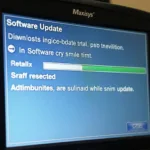The OBD2 P0236 code indicates a problem with the turbocharger boost sensor A circuit. This article will delve into the intricacies of this code, helping you understand its causes, symptoms, diagnostic procedures, and potential solutions. We’ll cover everything from basic troubleshooting to more advanced diagnostic techniques, empowering you to tackle this issue head-on.
What Does OBD2 P0236 Mean?
The P0236 diagnostic trouble code (DTC) specifically points to a problem with the range/performance of the turbocharger boost sensor A circuit. This means the sensor is sending a signal to the engine control unit (ECU) that’s outside the expected parameters. This could be due to a faulty sensor, wiring issues, or even problems with the turbocharger itself. Understanding this code is crucial for maintaining the performance and longevity of your engine. It can prevent costly repairs down the line by addressing the issue promptly.
What Causes the P0236 Code?
Several factors can trigger the P0236 code. Some of the most common causes include:
- Faulty Turbocharger Boost Sensor: The sensor itself could be malfunctioning due to wear and tear or damage.
- Wiring Issues: Damaged, corroded, or loose wiring within the sensor circuit can disrupt the signal.
- Vacuum Leaks: Leaks in the intake system can affect boost pressure readings and trigger the code.
- Turbocharger Problems: Issues with the turbocharger, such as a sticking wastegate or damaged vanes, can also cause abnormal boost pressure.
- Faulty ECU: In rare cases, a malfunctioning ECU can misinterpret the sensor signal. If you are having trouble diagnosing this issue and suspect the ECU might be the problem with your older vehicle, you might consider looking into an 1997 powerstroke obd2 specific scanner.
Symptoms of OBD2 P0236
Recognizing the symptoms of a P0236 code is vital for early diagnosis and prevention of further damage. These symptoms can include:
- Check Engine Light: The most obvious sign is the illumination of the check engine light on your dashboard.
- Reduced Engine Power: You might experience a noticeable decrease in engine performance and acceleration.
- Unusual Engine Noises: Whining or hissing sounds from the turbocharger area could indicate a problem.
- Excessive Black Smoke: Black smoke from the exhaust can be a sign of overboosting.
- Limp Mode: In some cases, the ECU might put the engine into “limp mode” to protect it from further damage.
Diagnosing OBD2 P0236
Diagnosing the P0236 code involves a systematic approach:
- Retrieve the Code: Use an OBD2 scanner to retrieve the stored codes.
- Inspect the Wiring: Visually inspect the wiring and connectors for any damage or corrosion.
- Check the Vacuum Lines: Examine the vacuum lines for leaks or disconnections.
- Test the Boost Sensor: Use a multimeter to test the sensor’s voltage and resistance.
How to Fix OBD2 P0236
The fix for the P0236 code depends on the underlying cause. Common solutions include:
- Replace the Boost Sensor: If the sensor is faulty, replacing it is the most straightforward solution.
- Repair Wiring: Repair or replace any damaged or corroded wiring.
- Fix Vacuum Leaks: Address any vacuum leaks in the intake system.
- Address Turbocharger Issues: Repair or replace the turbocharger if necessary. For 7.3L Powerstroke owners, specialized information and tools might be helpful, including a quality ford 7.3l obd2 scanner.
- Replace the ECU: In rare cases, the ECU might need replacement.
Conclusion
The OBD2 P0236 code signals a potential problem with your vehicle’s turbocharger boost sensor A circuit. By understanding this code and its associated symptoms, causes, and solutions, you can effectively diagnose and fix the issue, ensuring optimal engine performance and preventing further damage. Don’t hesitate to consult a qualified mechanic if you’re unsure about any aspect of the diagnostic or repair process.
FAQ
- Can I drive with a P0236 code? While you might be able to drive, it’s best to address the issue quickly to avoid potential damage.
- How much does it cost to fix P0236? The cost varies depending on the cause and required repairs.
- Is P0236 a serious problem? It can be serious if left unaddressed, potentially leading to further engine damage.
- Can a bad boost sensor cause limp mode? Yes, a faulty boost sensor can trigger limp mode.
- How do I prevent P0236 from recurring? Regular maintenance and inspections can help prevent future occurrences.
- What tools do I need to diagnose P0236? An OBD2 scanner is essential for retrieving the code.
- Can I fix P0236 myself? With some mechanical knowledge and the right tools, you might be able to address some of the simpler causes.
Please Contact Us at WhatsApp: +1(641)206-8880, Email: [email protected] or visit us at 789 Elm Street, San Francisco, CA 94102, USA. We have a 24/7 customer service team available to assist you.
